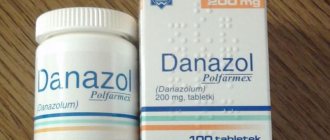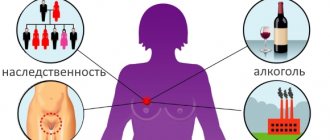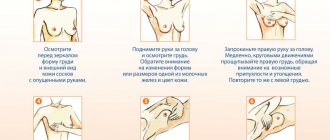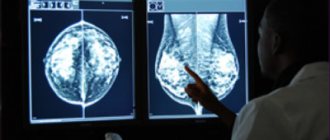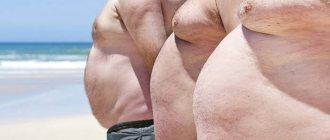Involution of the mammary glands is the process of physiological transformation of the glandular tissue of the mammary gland. It is not considered a pathology if it occurs during a certain period of a woman’s life associated with hormonal changes in the body. Involutive reformation of the mammary glands can be associated with the period of breastfeeding and menopause.
What changes occur in the breast?
To better understand why involutive changes in the breast occur, it is worth learning a little more about its structure.
How do breasts develop normally?
Immediately after birth, the mammary glands are a system of ducts, the final sections of which remain undeveloped. The lumens of the ducts are also not fully formed. Until puberty, breast tissue remains virtually unchanged.
Breasts begin to form most intensively during puberty. Due to the rapid development of stroma (connective tissue), the mammary glands begin to increase in size. A new qualitative stage of mammogenesis (breast development) is the appearance of lobules. At the same time, two types of connective tissue of the mammary gland are formed - intralobular and interlobular. In girls aged 15-16 years, the glandular tissue is poorly developed, and in 40% of cases it is not developed at all.
The mammary glands of girls and nulliparous young women, as a rule, have a polymorphic structure: along with lobules, they contain intermediate, immature structures, which include incompletely formed ducts and groups of ducts that are not divided into lobules.
Changes in the breast during lactation
The main period during which breast tissue is divided into different types is pregnancy and lactation. The cocktail of hormones produced by the body, which includes estrogen, growth hormone, progesterone, insulin and glucocorticosteroids, leads to the proliferation of the milk ducts, an increase in the volume of the epithelium, the formation of new lobules with the formation of small alveolar ducts at their ends. Thus, the mature lobules become alveolar lactating (milk-producing). In immature lobules, such transformation occurs later, therefore, for the full and healthy development of the breasts, it is important that the first pregnancy occurs during the period of completion of their morpho-functional maturation.
Involutive changes in the mammary glands after lactation
Involution, or the process of reverse development of breast tissue after breastfeeding, is an important stage in its normal development. Cessation of feeding leads to excessive production of the Fas gene, which triggers the process of apoptosis (death) of epithelial cells.
Age-related involutive changes in the breast
Starting at the age of 40, glandular tissue in the mammary glands begins to gradually be replaced by fatty tissue. It has been noted that in women who have given birth frequently, breast involution occurs more evenly, compared to women who have given birth infrequently and nulliparous women.
At the age of 50 to 60 years, fibrous tissue begins to form more intensively. After 60 years, the mammary glands in women are structurally infrequent milk ducts and lobules, localized in adipose tissue. If we consider the ratio of structures in the mammary glands, then by this age they consist mainly of adipose tissue, and fibrous tissue occupies approximately 25%.
How to diagnose and how to treat involutive mastopathy
Involutive changes in the mammary glands develop in women over 50 years of age, but the first signs may appear much earlier.
The process associated with an increase in fat deposits in the chest begins to progress to a greater extent in its lower inner part. As a rule, the upper outer region is subject to this phenomenon much less frequently.
Involutive mastopathy is not a serious disease and is sometimes considered as a normal option for women during menopause.
During menopause, the glandular tissue of the breast is replaced by fatty tissue.
Main features
It is very difficult to identify involutive mastopathy on your own. Most often, women pay attention to changes in the shape of the glands and loss of elasticity. Sometimes the breasts become noticeably enlarged, which may be accompanied by signs of mastodynia, which is characterized by soreness and some heaviness.
The diagnosis is made only after mammography, which, with involutive mastopathy, shows changes in the structure, an increase in the fat layer, a decrease in connective tissue and skin thickness.
In the image, the altered breast area appears translucent with distinct milk ducts and vasculature.
Involutive mastopathy is clearly manifested on mammography, which is recommended annually for all women after 40 years of age
Fibrous mastopathy of involutive form manifests itself on mammography with a large number of connective tissue formations. Sometimes the lymph nodes in the armpit area may also undergo changes, which appear as round dark spots with a light center.
Factors driving change
Involutive processes in the glands most often result from an imbalance in the hormonal sphere, which is manifested by a decrease in estrogen synthesis, a decrease in the volume of glandular tissues and the growth of adipose tissue.
After 45 years, a decrease in the production of this hormone is considered normal.
Earlier manifestations, as a rule, are the result of gynecological pathologies and require the use of therapeutic methods.
Unlike other forms of the disease, the level of estrogen in involutive mastopathy does not exceed the norm, but, on the contrary, decreases
Not only diseases in the reproductive sphere lead to a decrease in estrogen production. There are a number of factors that can provoke hormonal imbalance. These include:
- stressful situations;
- passion for alcohol;
- low physical activity;
- poor nutrition;
- abortion;
- short lactation period;
- chronic kidney or liver diseases.
One of the causes of the disease is pregnancy and childbirth at an advanced age.
Involutive changes can occur in women whose labor was late, as well as if there were no pregnancies.
Diagnosis of the disease
During self-examination, abnormalities in the structure of the tissues of the mammary glands are quite difficult to identify. It is involutive mastopathy that is usually detected during a routine examination by a mammologist, who performs a mandatory external examination and prescribes an ultrasound.
Breast examination with a mammograph is recommended for all women over 35 years of age.
X-ray of the breast - mammography - one of the most important measures for the prevention of mastopathy
This method is the most informative for various pathologies of the mammary glands. In most cases, it allows you to detect changes with high reliability.
Unfortunately, ultrasound examination does not always detect formations with a volume of less than 1 cm. This is why after 40 years it is necessary to undergo mammography once a year. For women over 55 years of age, it is advisable to carry out this type of examination twice a year.
Therapeutic measures
Since the involutive process associated with age is not a deviation, this condition does not usually require the appointment of any therapeutic measures.
Involutive mastopathy, detected in women during pre- and menopause, most often requires only periodic observation by a doctor
Nevertheless, women are recommended to undergo regular examinations in order to monitor changes in the tissue of the mammary glands. Young women need treatment for involutive mastopathy, and therapy should be aimed at eliminating the causes and normalizing hormonal levels.
If it turns out that the replacement of glandular tissue with adipose tissue is caused by endocrine disorders, replacement therapy is indicated for women. If focal structures and other abnormalities are identified, additional diagnostics are prescribed.
If mastopathy is accompanied by signs of mastodynia, in which women experience discomfort in the chest, engorgement, increased sensitivity, anti-inflammatory drugs and drugs with an analgesic effect are recommended.
At a young age and in the presence of painful symptoms, the prescription of medications is indicated
Plant-based preparations have good effects and a small number of side effects. Correction of hormonal levels is carried out using combined hormonal agents.
For swelling of the glandular tissues and to relieve inflammation, herbal medicine is recommended, which must be carried out for at least a month. If pain occurs, herbal remedies with a sedative effect can be used. The use of vitamins C, A, E helps improve microcirculation in the mammary glands. Courses with B vitamins have a good effect.
Preventive measures
To prevent the appearance of involutional changes in mammary gland tissue, you should give up bad habits.
Quitting smoking and alcohol significantly reduces the risk of developing mastopathy
An important factor in women’s health is a healthy diet, which involves reducing unhealthy carbohydrate foods, carbonated drinks, and fatty meats in the diet.
The menu should include porridge, vegetable dishes, compotes, and berries. During the summer season, you should try to eat more fresh fruits.
A woman's hormonal levels are also greatly influenced by products containing harmful preservatives and other substances. When purchasing, special attention should be paid to the composition of the food purchased. It is not worth purchasing various semi-finished products due to the presence of possible low-quality components in them.
https://youtu.be/y_hHkA1qLXk
Proper nutrition not only prevents mastopathy, but also heals the body as a whole.
The consumption of polyunsaturated fatty acids is beneficial for the health of the mammary glands and reproductive organs. The diet should include olive oil, fish, caviar, eggs.
The most important preventive measure to prevent mastopathy, including the involuting form, is regular examination and examination by a mammologist. It is very difficult to identify initial changes in the structure of the mammary glands on your own. It should be remembered that significant disorders and large formations are much more difficult to treat compared to non-advanced forms of the disease.
Much attention should be paid to moderate physical activity, which can be combined with daily walks in the fresh air.
To ensure healthy sleep, you can take mild sedatives
Adequate sleep is important, allowing the body to relax and recover. It is necessary to protect the breasts from direct sunlight.
If possible, you should not abandon the lactation period. Full breastfeeding for a year or more allows you to avoid many diseases associated with the mammary glands and hormonal levels.
To learn why your chest hurts and what to do about it, watch the video:
Source: https://bolezni.com/stati-o-boleznyah/mastopatiya/priznaki-involyutivnoj-mastopatii.html
Causes of involutive breast changes
Involution of the mammary glands is a natural process. Normally, it is due to specific reasons. One of these reasons is the aging of the body. During menopause, there is a sharp drop in estrogen levels. This is a kind of signal to the body, after which it stops forming glandular cells. They are replaced by adipose tissue. The breasts lose their shape and become flabby. In most cases, the mammary glands decrease in volume. They can only become larger if there is a large amount of fat deposited. As you approach old age, subcutaneous fat tissue becomes thinner throughout the body, including in the breasts. After 70-80 years, the mammary glands consist mainly of connective tissue.
Some people age faster than others, and this is determined by genetic factors that cannot be influenced. However, there are also lifestyle factors that can accelerate age-related changes, including the withering of the mammary glands. These include:
- smoking and alcohol abuse;
- lack of physical activity;
- excessive passion for solariums;
- systematic disruption of healthy sleep and wakefulness patterns;
- poor nutrition;
- frequent stress.
Weaning a child from the breast also causes involutive changes in the mammary glands. During pregnancy, the body prepares to produce milk. Serious changes occur in the breast: the number of milk ducts increases, the lobules become lactating. The breast increases in volume. At the end of the lactation period, the mammary glands reverse development - involution, the amount of glandular tissue in them decreases, the breasts return to their previous volume.
In both cases, involution is caused by hormonal changes in the woman’s body. It is impossible to say exactly when changes will begin - this process is individual for each woman. But there are certain limits. If involutive changes occur at a young age, this is a reason to consult a doctor.
Prevention
Compliance with prophylaxis allows you to prevent premature involution of the mammary glands and eliminate the presence of complications.
The basic rules are as follows:
- choose a diet that excludes fatty, smoked and salty foods;
- for edema, limit fluid intake;
- wear bras only made from natural fabrics;
- try to avoid stress;
- eliminate bad habits;
- after 40 years, visit a mammologist 1-2 times a year.
It is important to constantly carry out preventive measures. Thanks to them, all physiological changes in a woman’s body will occur naturally.
Signs of involutive changes
In the vast majority of cases, breast involution is asymptomatic. It is almost impossible to recognize it on your own. The only thing a woman can pay attention to is the structure of the mammary glands: they may become softer and flatter. Sometimes, especially in obese women, breasts may increase in size. This is explained by the fact that glandular tissue is replaced by adipose tissue.
The involutive process can only be accurately determined using ultrasound or mammography. With pronounced involution, the breasts will appear lighter in the images, with clearly visualized lobules, ducts, connecting cords and blood vessels.
Young and nulliparous women should pay special attention to signs of breast involution. In their case, this process can be caused by a serious hormonal imbalance, in which the replacement of glandular tissue with fatty tissue can be pathological.
The reason for this is sometimes a malfunction of the endocrine system, so nulliparous women under the age of 40-50 with signs of breast involution should undergo a diagnostic examination. In other cases, such a process is perceived as the norm.
How are signs of changes in the mammary glands detected?
One of the first ways to detect pathology in the mammary glands is self-examination. In the case of involution of the mammary glands, it will be quite difficult for a woman to determine this process on her own. However, any suspicious changes in the mammary glands, such as compactions, heterogeneous structure, discharge from the nipples and others, are a reason to consult a doctor.
The mammologist will examine and palpate the breasts. If necessary, imaging tests such as ultrasound, mammography, and CT scans of the breast will be ordered. In addition, a general blood test and a blood test for hormones are performed.
Diagnostics
To clarify the condition of the breast, women are prescribed an ultrasound (the optimal method up to 35–40 years) or mammography (breast x-ray is performed after forty and in complex cases of pathologies in young women). If pathological changes are detected, the mammologist additionally prescribes thermography, MRI, and ductography.
It is necessary to donate blood for hormones: for a comprehensive diagnosis, the doctor must know the level of FSH, progesterone, prolactin, testosterone. If diabetes is suspected, a woman undergoes a laboratory determination of her glucose level. If there is a suspicion that the endocrine glands are affected, then it is necessary to find out the degree of secretion of hormones from the thyroid gland, pituitary gland, and hypothalamus.
Look at a selection of effective methods for treating hyperandrogenism in women of different ages.
Read about the first signs and symptoms of diabetes insipidus in children, as well as about treatment of the disease at this address.
Follow the link https://vse-o-gormonah.com/articles/analizy-na-zhenskie-gormony.html and find out why you need to take tests for female hormones when planning a pregnancy.
Treatment of breast involution
Normally, after a certain age, glandular tissue is replaced by adipose or fibrous (connective) tissue. However, in some cases fibrocystic breast involution occurs. It manifests itself not only in areas of fibrous and fatty replacements, but also in the formation of cystic formations. On palpation, lumps are felt in the mammary glands. Ultrasound helps to accurately determine the amount of fibrous tissue and the location of cystic inclusions.
Consequences of fibrocystic breast involution
If the involution process proceeds pathologically, it can lead to the development of the following complications:
- Fibroadenoma is a benign breast tumor that is a dense discrete mass.
- Carcinoma is a malignant tumor of the breast, which in the early stages is defined as a painful lump. As it progresses, bloody or purulent discharge from the nipple may appear.
- Mastitis is an infection of the lactation structures of the mammary gland. Accompanied by pain and purulent discharge from the nipple.
- An abscess is a localized source of infection with an accumulation of pus.
- Phylloid tumor is a type of fibroadenoma arising from the interlobular stroma. On palpation, a compaction with a lobular structure is felt.
Treatment of fibrocystic breast changes
Depending on the severity of the process, treatment can be medicinal (hormone therapy) or surgical. At the same time, breast cancer is monitored using biopsy and radiological imaging. Lack of treatment leads to the development of severe pain and an increase in cystic lesions. The main danger of fibrocystic breast changes is the risk of developing carcinoma, a potentially fatal type of cancer.
Symptom management
To alleviate the condition of patients with fibrocystic involution, the following methods are used:
- use of analgesics to reduce pain;
- using non-steroidal anti-inflammatory drugs such as ibuprofen to control breast pain and inflammation;
- a course of vitamins A and E to relieve symptoms;
- drainage of cystic lesions with a fine needle;
- surgical removal of tumors causing discomfort, or mastectomy.
Drug therapy
Selective estrogen receptor modulators such as tamoxifen are used. These medications selectively inhibit (reduce) the effects of estrogen on breast tissue while maintaining other effects of estrogen in the body.
Maintenance therapy
- Lifestyle changes: Avoiding a high-salt diet and using diuretics at the end of each monthly cycle to control breast swelling.
- Be careful with contact sports, which can injure the breasts and aggravate swelling.
- Wearing a good supportive bra.
Complications of fibrocystic involution
Complications associated with fibrocystic breast involution may occur due to progression of the disease or problems associated with treatment:
- Invasive treatments such as fine needle aspiration or open surgery carry a risk of infection. It can also occur when fluid accumulates in the breast tissue for a long time.
- Fibrocystic changes in the breast can transform into carcinoma if surgery or hormonal therapy does not stop the process.
- Excessive expansion of breast tissue can lead to cosmetic defects.
Prognosis of fibrocystic breast involution
Fibrocystic changes are usually predictable and respond well to any form of treatment, be it surgery or drug therapy. The reason for visiting a doctor is usually severe pain and the formation of large cysts that cause discomfort. In most cases, fibrocystic involution goes away on its own after menopause.
One of the most common complications and the most common cause of death is the development of breast carcinoma. That is why women should pay attention to the process of breast involution, especially if it occurs at an early age and not in women who have given birth. Seeing a doctor in a timely manner will help you avoid serious problems and maintain the health of your breasts.



